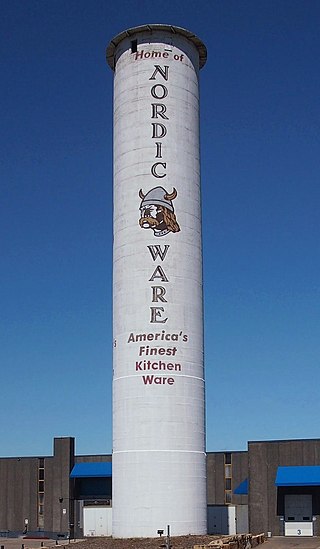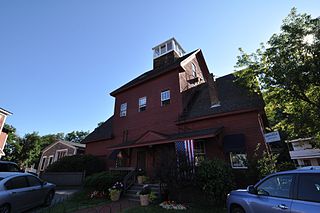
The Georgetown Loop Railroad is a 3 ft narrow gauge United States heritage railroad located in the Rocky Mountains in Clear Creek County, adjacent to Interstate 70 in Colorado.

Forbes Mill is a now-defunct flour mill originally built in 1854 located in Los Gatos, California, which served as the History Museum of Los Gatos after having been saved from destruction in 1982. The museum closed in 2014, and its collections are now part of New Museum Los Gatos. The building is currently owned by the City.

The Pillsbury A-Mill is a former flour mill located on the east bank of the Mississippi River in Minneapolis, Minnesota. It was the world's largest flour mill for 40 years. Completed in 1881, it was owned by the Pillsbury Company and operated two of the most powerful direct-drive waterwheels ever built, each capable of generating 1,200 horsepower . In 1901 one of the turbines was replaced with a 2,500 horsepower one. Both the mill and its headrace tunnel are contributing resources to the St. Anthony Falls Historic District, which is on the National Register of Historic Places. The mill is also independently on the NRHP. The mill was named a National Historic Landmark in 1966 and has since been converted into the A-Mill Artist Lofts.

The Peavey–Haglin Experimental Concrete Grain Elevator is the world's first known cylindrical concrete grain elevator. It was built from 1899 to 1900 in St. Louis Park, Minnesota, United States, as an experiment to prove the design was viable. It was an improvement on wooden elevators that were continually at risk for catching fire or even exploding. Its cylindrical concrete design became the industry standard in the United States, revolutionizing grain storage practices. After its initial experiments, the Peavey–Haglin Elevator was never again used to store grain. Since the late 1960s it has been maintained on the grounds of the Nordic Ware company and is painted with their name and logo.

The Bollinger Mill State Historic Site is a state-owned property preserving a mill and covered bridge that pre-date the American Civil War in Burfordville, Cape Girardeau County, Missouri. The park was established in 1967 and offers mill tours and picnicking. It is managed by the Missouri Department of Natural Resources. It includes the Burfordville Covered Bridge, which is listed on the National Register of Historic Places.

The Shenandoah-Dives Mill or Mayflower Mill is an intact and functional but inactive historic ore mill 2 miles (3.2 km) east of Silverton, Colorado, United States. The mill was built in 1929 to recover gold, silver, lead, zinc, and copper from ore mined at the Mayflower mine and brought to the mill by an aerial tramway. Regularly active until 1945, it houses still-functional equipment for the separation by flotation of metals from crushed ores. It is the only intact and functional mill of its kind in Colorado. It was included in the expanded Silverton Historic District in 1997, and was declared a National Historic Landmark on its own in 2000. The mill is owned by the San Juan County Historic Society, which staffs an information and gift shop at the mill under the name Mayflower Mill. The mill is open for self-guided tours in the summer months.

This list is of the properties and historic districts which are designated on the National Register of Historic Places or that were formerly so designated, in Hennepin County, Minnesota; there are 190 entries as of April 2023. A significant number of these properties are a result of the establishment of Fort Snelling, the development of water power at Saint Anthony Falls, and the thriving city of Minneapolis that developed around the falls. Many historic sites outside the Minneapolis city limits are associated with pioneers who established missions, farms, and schools in areas that are now suburbs in that metropolitan area.

The Marine Mill, established in 1839, was the first commercial sawmill in what became the U.S. state of Minnesota. Now in ruins, it is currently a historic site managed by the city of Marine on St. Croix in partnership with the Minnesota Historical Society. It was listed on the National Register of Historic Places as the Marine Mill Site in 1970 for having state-level significance in the themes of exploration/settlement, industry, and transportation. It was nominated for being the birthplace of the region's seminal industry—lumbering—and a major landing on its crucial transportation route, the St. Croix River. The site is also a contributing property to the Marine on St. Croix Historic District.

The Quaker Flour Mill, also known as Show Room , is a historic building in Pueblo, Colorado. The building once served as a flour mill and in 1976 it was a theatre. It was listed on the National Register of Historic Places in 1976.

This is a list of the National Register of Historic Places listings in Otter Tail County, Minnesota. It is intended to be a complete list of the properties and districts on the National Register of Historic Places in Otter Tail County, Minnesota, United States. The locations of National Register properties and districts for which the latitude and longitude coordinates are included below, may be seen in an online map.

The Sheridan Flouring Mills, also known as the Mill Inn, are an industrial complex in Sheridan, Wyoming. The mills were a major component of the economy of north central Wyoming, providing collection, storage and milling of locally produced wheat and other grains into flour and other milled products. The original mill was established by Captain Scott W. Snively in the early 1890s. The Sheridan Milling and Manufacturing Company was sold to J.W. Denio in 1903, who operated the mill at its location on Broadway Avenue near downtown Sheridan. A catastrophic fire destroyed this mill in 1919, resulting in the purchase of a new location on Coffeen Avenue and construction of a much larger mill.

The Kent Industrial District is a historic district in Kent, Ohio, United States, listed on the National Register of Historic Places. The district covers around 4.3 acres (1.7 ha) of downtown Kent on either side of the Cuyahoga River and is roughly bounded by West Main Street on the north, River Street to the west, Franklin Avenue to the east and Haymaker Parkway to the south. Within the district are three buildings and two stone structures of historical significance. It was listed on the National Register of Historic Places in 1974. Kent namesake Marvin Kent was involved in several aspects of the district's development and the area would play a key role in the development of Kent during much of the 19th century. The earliest structures in the district date to the 1830s with the most recent historic structure, the livery and carriage shop building, dating to 1910. The area today is occupied mostly by the city of Kent's Franklin Mills Riveredge Park, Heritage Park, and various private landowners.

The Newlin Mill Complex, also referred to as The Newlin Grist Mill, is a water-powered gristmill on the west branch of Chester Creek near Concordville, Pennsylvania built in 1704 by Nathaniel and Mary Newlin and operated commercially until 1941. During its three centuries of operation, the mill has been known as the Lower Mill, the Markham Mill, the Seventeen-O-Four Mill and the Concord Flour Mill. In 1958 the mill property was bought by E. Mortimer Newlin, restored and given to the Nicholas Newlin Foundation to use as a historical park. Water power is still used to grind corn meal which is sold on site. The park includes five historical buildings, which were added to the National Register of Historic Places in 1983, and 150 acres (61 ha) of natural woodland.

Mill City Museum is a Minnesota Historical Society museum in Minneapolis. It opened in 2003 built in the ruins of the Washburn "A" Mill next to Mill Ruins Park on the banks of the Mississippi River. The museum focuses on the founding and growth of Minneapolis, especially flour milling and the other industries that used hydropower from Saint Anthony Falls.

The Great Valley Mill, also known as the Old Grist Mill in the Great Valley, is an historic grist mill which is located in Tredyffrin Township, Chester County, Pennsylvania.

The Ashland Gristmill and Dam are a historic former industrial facility in the heart of Ashland, New Hampshire. Built in 1903 on the site of an older mill, the gristmill demonstrates the continuing viability of wood framing for mill buildings in an era when it had become uncommon. The property was listed on the National Register of Historic Places in 1979. It has been converted to professional offices.
The Brigham City Co-op was one of the most successful cooperative enterprises of the Mormons in Utah.

The Cheyenne Flour Milling Company, also known as the Standard Oil Company and Salt Creek Freightways, is an early warehouse building in Cheyenne, Wyoming. The structure was built in 1927 to house goods brought to and from Cheyenne by the Union Pacific Railroad in an industrial section of Cheyenne as a flour mill, replacing structures that had performed similar functions since 1915. By 1931 the building was shared by a warehouse for electrical parts for the Mountain States Telephone and Telegraph Company, a potato chip factory and a chemical products company. In 1937-38 the Standard Oil Company started to use the warehouse for bulk petroleum products storage, continuing to 1963. From 1963 the building was used by Salt Creek Freightways, which had shared use from 1936. In 1973 it became a plumbing parts warehouse, and by 2003 was owned and used by a general contractor.

Gadow's Mill is a former grist mill on the Milwaukee River in West Bend, Wisconsin, United States, that is listed on the National Register of Historic Places (NRHP).




















